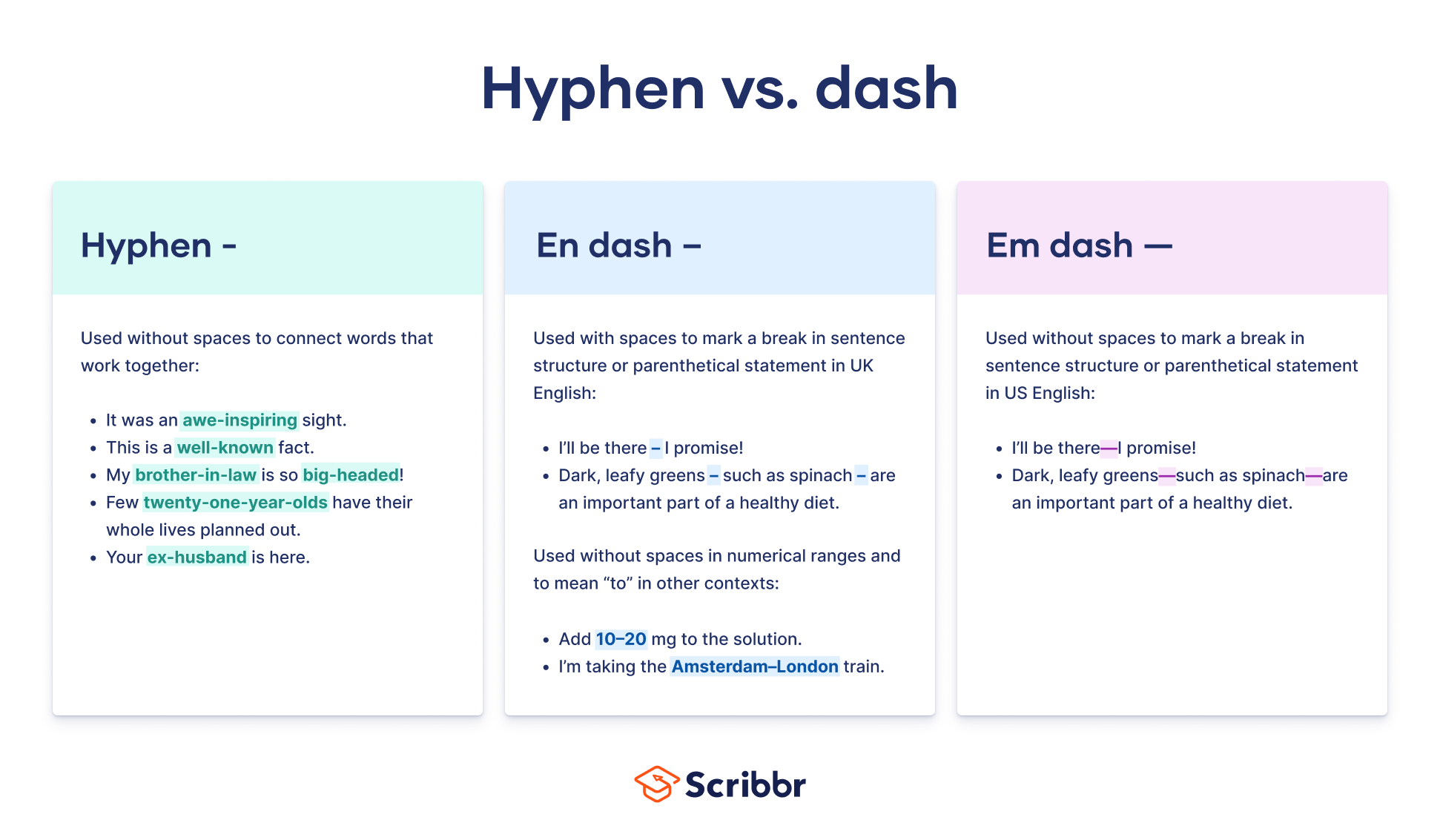Em Dash (—) vs. En Dash (–) | How to Use in Sentences
There are two types of dash. The en dash is approximately the length of the letter N, and the em dash the length of the letter M.
- The shorter en dash (–) is used to mark ranges and with the meaning “to” in phrases like “Dover–Calais crossing.”
- The longer em dash (—) is used to separate extra information or mark a break in a sentence.
The en dash is sometimes also used in the same way as an em dash, especially in UK English; in this case, it takes a space on either side.
Make sure not to confuse dashes with shorter hyphens (-), which are used to combine words (as in well-behaved or long-running). A hyphen should not be used in place of a dash.
The em dash: Marking a break in a sentence
Em dashes can be used in pairs to mark off additional information that is not essential to understand the sentence. Here they function similarly to parentheses or a pair of commas.
An em dash is usually written without spaces on either side, although some style guides do recommend using spaces. When in doubt, opt for no spaces, and make sure you’re consistent throughout your text, whatever you choose.
An em dash can also be used to mark a break in a sentence in place of a semicolon or colon. In this context, dashes are often used for emphasis or to signal a change in tone:
Note, however, that dashes used in this way are considered more informal than other punctuation marks, so should be used sparingly and selectively in academic writing.
Here's why students love Scribbr's proofreading services
The en dash: Marking a range
The main use of the en dash is to indicate a range of numbers or a span of time. You can read it as representing “to” or “through”:
Make sure to use en dashes, not hyphens, for numerical ranges like this.
Note that in the phrases “from … to …” and “between … and …,” it’s standard to retain the word “to” or “and” instead of using an en dash, to maintain parallel construction in the sentence.
- The rooms were between 15–20 meters wide.
- The rooms were between 15 and 20 meters wide.
Other uses of the en dash
The en dash also appears occasionally in other contexts.
En dashes meaning “to” or “and”
An en dash may express the meaning of “to” or “and” in situations other than numerical ranges—for example describing directions, relationships, or scores (in a vote or game).
En dashes in place of hyphens
More rarely, an en dash is used in place of a hyphen in a compound adjective. Specifically, an en dash is preferred when one element of the compound is itself an open compound.
For example, the prefix post- is usually connected to the following word with a hyphen, but to connect it to the compound noun World War II, it’s better to use an en dash.
This usage of the en dash can be difficult to understand and get right. If in doubt, use a hyphen or the punctuation checker.
British style: En dashes in place of em dashes
You might also see an en dash used in the same way as an em dash, especially in British English and in less formal writing. In this context, the en dash always takes a space on either side:
This usage of the en dash is considered standard in British English (though Oxford style prefers the em dash).
If you choose to use en dashes in this way, make sure to do so consistently, and to use spaces. A common mistake is using both forms in the same text or spacing the punctuation incorrectly:
- Jeff Bezos–who is the founder, chairman, CEO, and president of Amazon—is one of the richest people in the world.
- Jeff Bezos—who is the founder, chairman, CEO, and president of Amazon—is one of the richest people in the world.
- Jeff Bezos – who is the founder, chairman, CEO, and president of Amazon – is one of the richest people in the world.
Sources in this article
We strongly encourage students to use sources in their work. You can cite our article (APA Style) or take a deep dive into the articles below.
This Scribbr articleLuo, A. (2023, October 20). Em Dash (—) vs. En Dash (–) | How to Use in Sentences. Scribbr. Retrieved April 15, 2024, from https://www.scribbr.com/language-rules/dashes/
Butterfield, J. (Ed.). (2015). Fowler’s dictionary of modern English usage (4th ed.). Oxford University Press.
Garner, B. A. (2016). Garner’s modern English usage (4th ed.). Oxford University Press.

